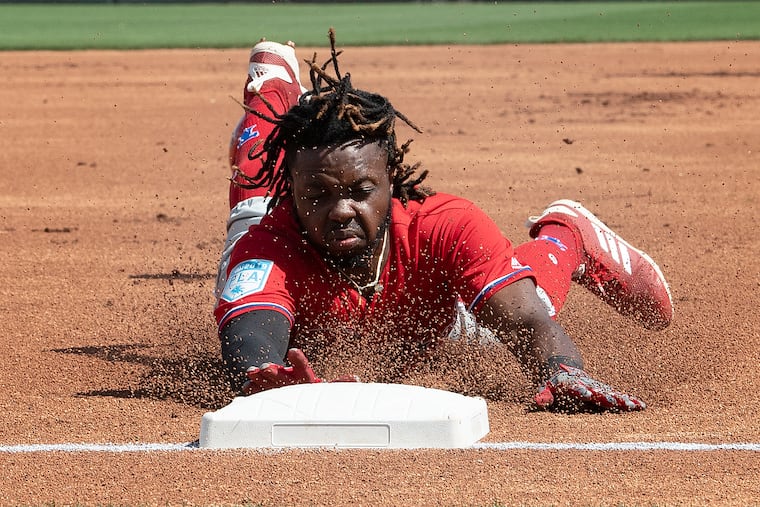As oft-injured Roman Quinn nears a return, Phillies ponder ways to keep him healthier
Name the injury, and Quinn has probably had it, leading the Phillies to wonder how often he can play.

During the most-active stretch of playing time in his brief big-league career, Roman Quinn started 12 of 19 games last August and September and went 18-for-49 with a .404 on-base percentage, three doubles, three triples, one home run, and five stolen bases.
The Phillies surely can use that type of spark right now.
But as Quinn closes in on his latest return from the injured list — he could be added to the roster as soon as Friday night in Atlanta before the opener of a big three-game series against the Braves — there is uneasiness, too. The blazing-fast 26-year-old center fielder hasn’t played more than 88 games in a season since the Phillies drafted him in 2011. His list of maladies includes a torn quadriceps, torn Achilles tendon, strained elbow ligament, torn ligament in his middle finger, concussion, and a broken toe. This year alone, he missed most of spring training with a strained oblique muscle and the last seven weeks with a Grade 2 strain of his right groin.
Name the injury, and Quinn most likely has had it.
Quinn is an electrifying player, but it’s rare that he’s able to stay on the field for more than a few weeks at a time. So, although the Phillies need him with Andrew McCutchen out for the season and Odubel Herrera awaiting a court date on Monday and a possible suspension for his involvement in an alleged domestic-assault incident, they will take a conservative approach to working Quinn into the lineup.
“Workload management is huge,” manager Gabe Kapler said this week in his best Brett Brown-on-Joel Embiid impression. “A likely scenario is we try to ease him in by giving him a platoon advantage as a right-handed hitter. And, perhaps, that gives us the opportunity to keep him healthier.”
Indeed, when Quinn does return, it will be exclusively as a right-handed hitter, a change that was driven from a performance standpoint but also might help with load management.
The Phillies encouraged Quinn to take better advantage of his speed by becoming a switch hitter in the minor leagues. And because there are far more right-handed pitchers than lefties, 64 percent of his at-bats in the minors and 69 percent in the majors have come from the left side of the plate.
Quinn, naturally right-handed, remained stronger from that side. But he wasn’t a left-handed train wreck, either. In the minors, he batted .265 from the left side, compared to .325 from the right. At the big-league level, he’s a .230 hitter from the left side, compared to .292 from the right.
“Roman always wanted to hit from his most comfortable side, the right side,” Kapler said. "I also think Roman always wanted to play center field. There were visions by some people who were very creative that it would help him to hit from both sides and potentially play the infield, as well.
"The thing that we’re considering most is, how does he feel most comfortable and confident. If a guy doesn’t feel confident going up to the plate left-handed, and he feels confident going up to the plate right-handed, his best chance of success is probably to hit right-handed.”
But the switch from switch hitting also gives the Phillies a strategic reason to provide Quinn additional rest. If they start him only against left-handed pitching, perhaps his body will have a greater chance to recover between games.
“I feel like it’s easier on my body, for sure,” Quinn said before his rehab assignment. “As far as easier hitting-wise, I’m not sure yet. I think it had some [physical] effect just because of how much work I put in as a hitter. There’s times during the season where I feel great switch-hitting, feel great from the left side, and then I get hurt and feel like I have to start all over again. It’s hard for me to get in a rhythm like that."
As well as Scott Kingery has played in center field in the absence of Herrera and McCutchen, he’s a natural infielder. With Maikel Franco producing almost nothing at the plate for six weeks, the Phillies would prefer to give Kingery a long run of starts at third base.
In an ideal world, Quinn would play center field against left-handed pitching, and lefty-hitting prospect Adam Haseley would start against righties. But Haseley is on the injured list with a strained left groin.
Regardless, the Phillies are sensitive to Quinn’s injury history and searching for ways to keep him healthier. Quinn has tried almost everything over the years, including changing his pregame stretching routine and even his diet.
“We don’t know when that moment is that he has a muscle injury, a soft-tissue injury," Kapler said. "It’s very difficult for us to predict. We’ve tried it in many different ways. Maybe the move is taking off the kid gloves. Maybe the move is being more cautious. But we’re still learning as much as we can at this point.”
One thing is clear: The Phillies would love for Quinn, whether he bats right-handed or left, to get as hot as he did at the end of last summer.
“If he looks like how he looked last year,” Kapler said, “it’s going to be hard for us not to give him those opportunities.”